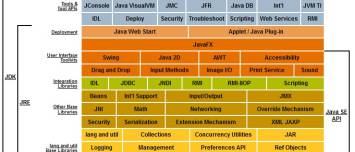About
A Java module is a packaging format that create a modular JAR file.
It's a feature of JDK 9 from the Java Platform Module System (JPMS) that divide the monolithic rt.jar and tools.jar files into 75 distinct modules (at least in the OpenJDK, the Oracle JDK contained a few more).
Format and minimal example
Structure
The module consists of two type of source files:
- the module declaration file: module-info.java
- and the classes
By convention, the source code for the module is in a directory that is the name of the module.
src/com.greetings/com/greetings/Main.java
src/com.greetings/module-info.java
module-info.java
- Minimal
module com.greetings { }
- Exporting code to be used as a library (ie making it visible to other)
module com.greetings {
exports com.greetings;
}
- Service (Service Provider Interface) (more info at quick start jigsaw)
module com.socket {
exports com.socket;
exports com.socket.spi;
uses com.socket.spi.NetworkSocketProvider;
}
Compile
With javac
Creation of the directory tree to get the output of the compilation
mkdir -p mods # the root module path
mkdir -p mods/com.greetings # the location of the module
The compilation
javac
-d mods/com.greetings \ # the target directory for the output of the compiled module
--module-path mods \ # the module path permits to resolve external modules (ie code dependencies)
src/com.greetings/module-info.java \
src/com.greetings/com/greetings/Main.java
compile multiple modules with one javac command
mkdir mods
javac -d mods --module-source-path src $(find src -name "*.java")
package com.greetings;
public class Main {
public static void main(String[] args) {
System.out.println("Greetings!");
}
}
Package (Modular Jar)
package - The contents of the compiled modules are exploded on the file system. For transportation and deployment purposes then it is usually more convenient to package a module as a modular JAR.
A modular JAR is a regular JAR file that has a module-info.class in its top-level directory.
mkdir mlib
# create [email protected]
jar --create --file=mlib/[email protected] \
--module-version=1.0 -C mods/org.astro .
# create com.greetings.jar
jar --create --file=mlib/com.greetings.jar \
--main-class=com.greetings.Main -C mods/com.greetings .
Run
To run a modular jar
java -p mlib -m com.greetings
where:
- m specifies the main module
To run raw class file exploded on the file system
java \
--module-path mods \
-m com.greetings/com.greetings.Main
where:
- The m option specifies the main module, the value after the slash is the class name of the main class in the module.
Type
Multi-Release
Modular JAR files can also be Multi-Release JAR files - ie extend the JAR file format to allow multiple, Java-release-specific versions of class files to coexist in a single archive. (per JEP 238)
Management
Describe the module
print the module declaration for a module packaged as a modular JAR.
jar --describe-module --file=mlib/[email protected]
Tool
Linker
jlink is the linker tool and can be used to link a set of modules, along with their transitive dependences, to create a custom modular run-time image.
Gradle
Documentation / Reference
- http://openjdk.java.net/projects/jigsaw/ - goals are to make implementations of the Platform more easily scalable down to small devices,
